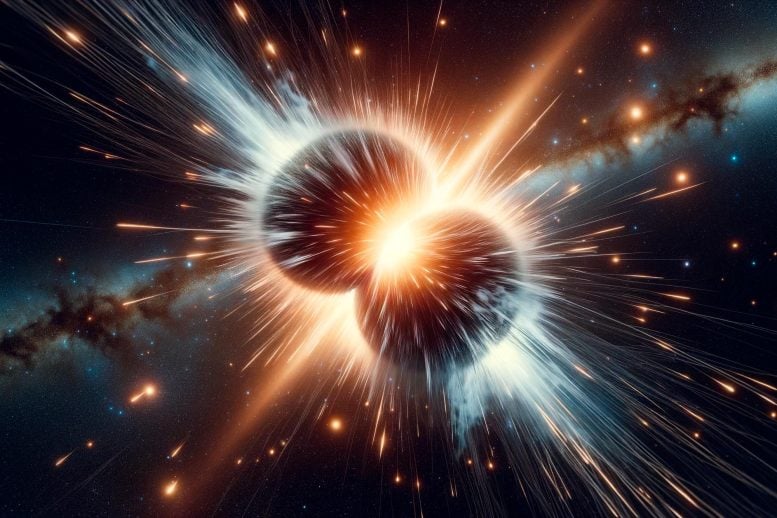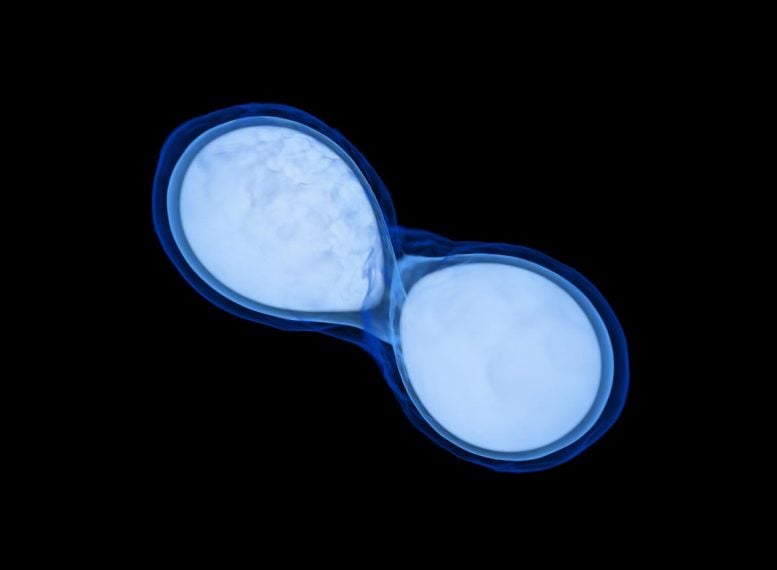
When binary neutron stars collide, hot neutrinos can briefly become trapped at the interface, remaining out of equilibrium with the cold cores of the merging stars for 2 to 3 milliseconds. This interaction helps bring the particles toward equilibrium and offers new insights into the physics of these mergers. Credit: SciTechDaily.com
New simulations show that neutrinos created during these cataclysmic
” data-gt-translate-attributes=”({“attribute”:”data-cmtooltip”, “format”:”html”})” tabindex=”0″ role=”link”>neutron star collisions are briefly out of thermodynamic equilibrium with the cold cores of molten stars.
Recent simulations by physicists at the University of Pennsylvania have shown that during the merger of binary neutron stars, hot neutrinos can briefly become trapped and remain out of equilibrium, providing insight into these cosmic events. This research underscores the role of simulations in studying phenomena that cannot be reproduced experimentally.
What happens when neutron stars collide?
When stars collapse, they often leave behind incredibly dense but relatively small and cool remnants called neutron stars. If two stars collapse in close proximity, the remaining binary neutron stars spiral around each other and eventually collide, heating the collision point to extreme temperatures.
New simulations of these events show that hot neutrinos (tiny, essentially massless particles that rarely interact with other matter) created during the collision can be briefly trapped at these interfaces and remain out of equilibrium with the cold nuclei of the molten stars for 2 to 3 milliseconds. Meanwhile, simulations show that neutrinos can interact weakly with star matter, helping to bring particles back toward equilibrium and providing new insights into the physics of these powerful events.
Revolutionary simulations of neutron star mergers
A paper describing the simulations, written by a research team led by Penn State physicists, was recently published in the journal Physical Exam Letters.
“For the first time in 2017, we observed signals of all kinds here on Earth, including
” data-gt-translate-attributes=”({“attribute”:”data-cmtooltip”, “format”:”html”})” tabindex=”0″ role=”link”>gravitational wavesfrom a binary neutron star merger,” said Pedro Luis Espino, a postdoctoral researcher at Penn State and the University of California, Los Angeles.
” data-gt-translate-attributes=”({“attribute”:”data-cmtooltip”, “format”:”html”})” tabindex=”0″ role=”link”>University of California, Berkeleywho led the research. “This has sparked a huge amount of interest in the astrophysics of neutron binary stars. There is no way to reproduce these events in the laboratory to study them experimentally. So the best way to understand what happens in a neutron binary star merger is to do simulations based on mathematics from Einstein’s theory of general relativity.”

Volume rendering of density in a simulation of a binary neutron star merger. New research shows that neutrinos created in the hot interface between merging stars can briefly become trapped and remain out of equilibrium with the cool cores of the merging stars for 2 to 3 milliseconds. Credit: David Radice, Penn State
Composition of neutron stars and collision dynamics
Neutron stars get their name because they are composed almost entirely of neutrons, uncharged particles that, along with positively charged protons and negatively charged electrons, make up atoms. Their incredible density (only black holes are smaller and denser) appears to compress protons and electrons, fusing them to form neutrons. A typical neutron star is only a few dozen kilometers across, but its mass is about one and a half times that of our Sun, which is about 1.4 million kilometers across. A teaspoon of neutron star material could weigh as much as a mountain, or tens or hundreds of millions of tons.
“Neutron stars before they merge are indeed cold. Even though they can reach billions of degrees Kelvin, their incredible density means that this heat contributes very little to the energy of the system,” said David Radice, assistant professor of physics and of astronomy and astrophysics at the Eberly College of Science from Penn State University and leader of the research team. “When they collide they can become very hot, the interface of colliding stars can be heated to temperatures of several trillion degrees Kelvin. However, they are so dense that photons cannot escape to dissipate heat; we think they cool by emitting neutrinos. »
Insights into neutrino behavior in star mergers
According to the researchers, neutrinos are created during the collision when neutrons from stars collide and are destroyed into protons, electrons and neutrinos. What happens next in the first moments after a collision is an open question in astrophysics.
To try to answer this question, the research team created simulations that required considerable computing power to model the merger of binary neutron stars and all the associated physics. The simulations showed for the first time that, even briefly, even neutrinos can be trapped by the heat and density of the merger. Hot neutrinos are out of equilibrium with the still-cool cores of the stars and can interact with the stellar matter.
“These extreme events push the boundaries of our understanding of physics, and studying them allows us to learn new things,” Radice said. “The period during which the merging stars are out of equilibrium is only 2 to 3 milliseconds, but since temperature is relative, time here is relative, the orbital period of the two stars before merging can be as short as 1 millisecond. It is in this brief out-of-equilibrium phase that the most interesting physics occurs: once the system returns to equilibrium, the physics is better understood.”
The researchers explained that the precise physical interactions that occur during the merger may impact the types of signals that might be observed on Earth from binary star mergers.
“How neutrinos interact with star matter and are ultimately emitted can impact the oscillations of the merged remnants of the two stars, which can in turn impact the appearance of the electromagnetic and gravitational signals from the fusion when they reach us here on Earth,” Espino said. “Next generation gravitational wave detectors could be designed to look for these kinds of signal differences. In this way, these simulations play a crucial role in allowing us to gain insight into these extreme events while also informing future experiments and observations in a sort of feedback loop. »
Reference: “Neutrino trapping and non-equilibrium effects in neutron-star fusion binary remnants” by Pedro Luis Espino, Peter Hammond, David Radice, Sebastiano Bernuzzi, Rossella Gamba, Francesco Zappa, Luís Felipe Longo Micchi and Albino Perego, May 20, 2024,
Source link